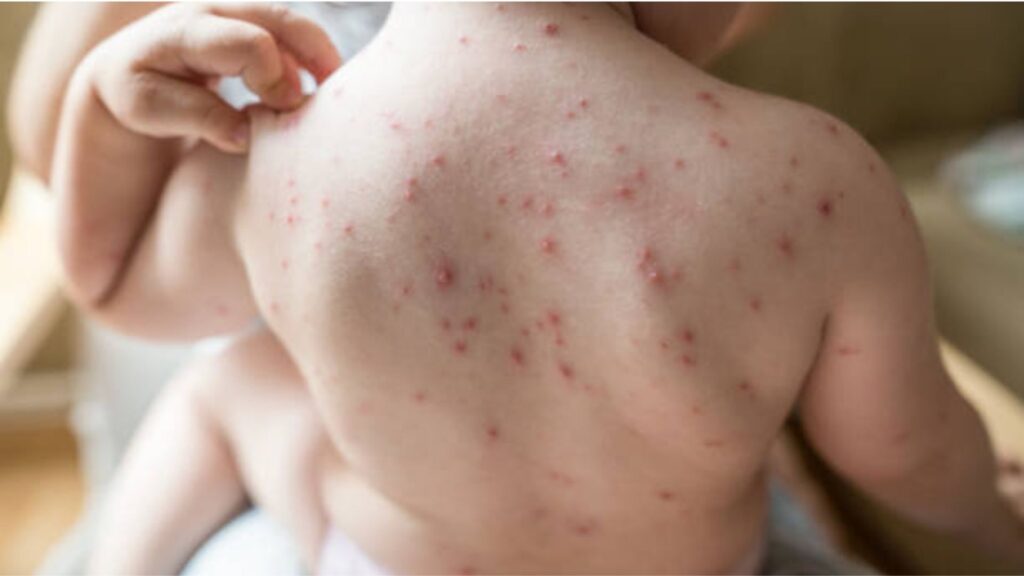Chicken pox : Symptoms, treatment & complication
Chicken pox
We have described in article :
Definition of chicken pox
Symptoms of chicken pox
Treatment of chicken pox
Complications of chicken pox
Epidemiology of chicken pox
Prevention of chicken pox

Definition of Chicken pox :
Definition : Chicken pox is an acute, highly infectious disease caused by varicella zoster virus.
Epidemiology of chicken pox :
- Occurrence : Worldwide
- Agent : Varicella zoster
- Reservoir/host : Man
- Environment : More common in winter and spring
- Mode of transmission : Droplet infection / Direct Contact/Air brone
- Incubation period : 2 to 3 weeks (14-17 days).
- Immunity : One attack gives durable immunity, second attacks are rare.
Symptoms of chicken pox :
A. The first symptoms of chicken pox include :
- Headache
- Fever
- Sore throat
- Backache
- Feeling generally unwell.
Once the chicken pox rash appears, it goes through three phases :
- Raised pink or red bumps (papules) which break out over several days.
- Fluid-filled blisters (vesicles) forming from the raised bumps over about one day before breaking and leaking
- Crusts and scabs, which cover the broken blisters and take several more days to heal.
Clinical features of chicken pox :
Clinical spectrum of chicken pox may vary from a mild illness and only a few scattered lessons to febrile illness and widespread rash. The clinical course of chicken pox may be divided into two stages :
Pre – eruptive stage:
- Mild to moderate fever
- Pain in the back
- Shivering
- Malaise
Eruptive stage :
In children the rash is often the first sign.
Distribution :
- Rashes are symmetrical.
- First appears in trunk abundant).
- They come to face, arms, and where it is less abundant.
- Mucosal surface usually affected
- Axilla may be affected.
- Palms and soles are not usually affected.
- Centripetal
2) Rapid evolution : Stages – Macule Papule, Vesicle, Scab
- Vesicles are filled and fluid be and looking like dew drops on the skin.
- Vesicles may form crust without going through pustular stage.
3) Pieomorphism : All the stages of the rash (papule, vesicle, crust) may be seen simultaneously at one time in the same area.
4) Fever : Fever does not run high but shows exacerbations and each fresh crop of eruption.
Treatment of chicken pox :
- Rest
- Pain relief such as paracetamol to relieve fever.
- Itching can be treated with lotions such as calamine available.
- Tepid baths with ½ cup of sodium bicarbonate or solutions such as Pinetarsol added can also be helpful in relieving itching.
- To prevent infection of the sores, trim children’s fingernails short and wash hands frequently with antibacterial soap.
- Antibiotic therapy such as Flocloxacillin 500mg 6-hourly should be prescribed if secondary bacterial infection progresses.
Complications of chicken pox :
- Haemorrhage (Varicella haemorrhagica)
- Pneumonia
- Encephalitis
- Acute cerebral ataxia
- Reye’s syndrome (acute encephalopathy associated & fatter degeneration of viscera especially liver).
- Congenital defects and malformation (foetal wastage, cutaneous scar, atrophied limbs, microcephaly, low birth weight, cataract, microphthalmia chorioretinitis, deafness and cerebro – cortical atrophy).
- Oncogeneity
- Skin infection
- Septicemia
- Septic arthritis.
Prevention of chickenpox :
- Varicella Zoster Immunoglobulin (VZIG) : Varicella-Zoster Immunoglobulin (VZIG) given within 72 hours of exposure for prevention of chickenpox in exposed susceptible individuals particularly in immuno-suppressed persons. These include –
- Susceptible persons receiving im unosuppressive therapy.
- Persons with congenital cellular immunodeficiency.
- Persons with acquired immunodeficiency including HIV/AIDS.
- Susceptible and exposed persons, in particular pregnant women.
- Newborn.
- Premature infants of low birth weight.
2) Vaccine : A live attenuated varicella virus vaccine is safe and currently recommended for children between 12-18 months of age who have not had chickenpox. The high-risk groups are
- Health-care workers
- Household contact of immuno-suppressed individuals.
- Persons who live or work in environments where transmission can occur e.g. college students, teachers, non-pregnant woman of childbearing age etc.
Control of chickenpox :
The usual control measures are –
- Notifications
- Isolation of cases for about 6 days after onset of rash.
- Disinfection of articles soiled by nose and throat discharges.
- Ay Antiviral therapy acyclovir, valacylovir, famiciclovir and foscarnet.
Some important about chicken pox :
1) . Incubation period : About 15 days (range 7-21 days)
2) Distribution of rash :
- Centripetal
- Seldom affected.
- Axilla affected.
- Rash mostly on flexor surfaces.
3) Characteristics of rash :
- Superficial.
- Unilocular, dew-drop like appearance.
- Rash pleomorphic.
- An area of inflammation is seen around the vesicles.
4) Evolution of rash :
- Evolution of rash very rapid.
- Scabs begin to from 4-7 days after the rash appears.
6) fever :
- Temperature rise with each fresh crop of rash.

Hello, you used to write magnificent, but the last several posts have been kinda boring?K I miss your tremendous writings. Past few posts are just a little out of track! come on!